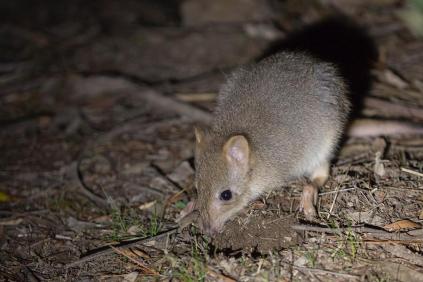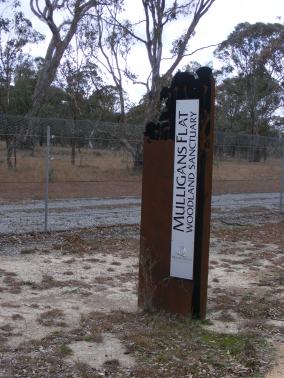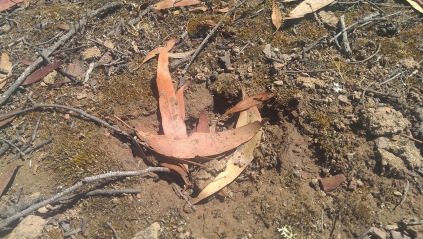If you went for an evening walk in the bush over a century ago, before the city of Canberra was founded, what might you have seen? Apart from the kangaroos and possums we’re familiar with today, the woodlands would have been teeming with small animals such as bandicoots, bettongs, quolls, antechinus and native mice. If you look closely, you would also have seen that the ground was full of holes where digging animals like the eastern bettong have been foraging for food, turning over the soil and leaf litter in search of truffles, roots and grubs. Today, Mulligan’s Flat Wildlife Sanctuary in the north of Canberra is the only place on the Australian mainland where you can see an eastern bettong, and for my PhD I’m lucky enough to be studying how these cute little digging machines are changing the ecosystem since their reintroduction 3 years ago.
What is an ecosystem engineer?
Ecosystem engineers are animals that modify, maintain or create habitats for other organisms, either through their own physical structure (e.g. corals, trees, kelp) or by changing the environment through their behaviours (e.g. beavers, earthworms, termites). Many other species rely on the resources provided by ecosystem engineers, so there can be far reaching consequences if they disappear.
Digging or burrowing animals are often considered to be ecosystem engineers because their diggings change the availability of certain resources and provide habitat for other species. Particularly in areas with harsh climates or limited resources, diggings provide protection from the elements and collect litter, water, and seeds, creating hot-spots of productivity and diversity.
Since European settlement and the introduction of cats and foxes, many of the small digging animals such as bandicoots and bettongs that were once abundant in south-eastern Australia have become extinct, or survive only in the remaining small pockets of woodland. The eastern bettong became extinct on mainland Australia around 100 years ago, but is still relatively common in Tasmania where cats and foxes are less of a threat.
Bettongs are rabbit sized nocturnal marsupials that feed mainly on native truffles, roots and grubs. Truffles are the underground fruiting bodies of mycorrhizal fungi, which form a symbiotic relationship with eucalypts and other plants allowing them to access more nutrients from the soil. Bettongs are prolific diggers – one individual can create over 200 diggings per night and turn over almost 3 tonnes of soil per year. It is thought that this disturbance is important for nutrient cycling, water infiltration, spreading fungal spores, and also creating suitable sites for seed germination.

My study site – Mulligan’s Flat and Goorooyarroo Nature Reserves
Mulligan’s Flat and Goorooyarroo are two neighbouring reserves on the northern outskirts of Canberra, right on the border with NSW and total around 800 hectares. They were established to protect some of the most intact remnants of box gum grassy woodlands, and to provide a site for research into how these ecosystems function and how they can be managed and restored. Although the reserves are relatively undisturbed, they have been degraded through clearing and grazing in the past. Some of the research to date has looked at the effects of different management strategies, such as controlling kangaroo grazing, burning and the addition of logs to provide habitat.

The ACT Government provided funding to build an 11.5km predator-proof fence in Mulligan’s Flat which was completed in 2009, creating a 480ha area that is free of foxes and cats. The fence not only provides protection for the native wildlife in the reserve, but has also allowed the reintroduction of several species which have been extinct in the area for decades, including the eastern bettong, new holland mouse and bush stone curlew. There are plans over the next few years to reintroduce more species, with the aim of returning the reserve as much as possible to its pre-European condition.
Since the bettongs were reintroduced at Mulligan’s Flat in 2012, their population has increased from 32 founders to over 200 known individuals. So far they seem to be thriving and their characteristic diggings are clearly visible in many areas of the reserve.
My PhD project
For the next three years I will be studying what impact the bettong reintroduction is having on the ecosystem within the reserve, and whether they might play a role in rehabilitation. I particularly want to know if the diggings are beneficial for seed germination, and if this is having an effect on the abundance and diversity of plant species.
The bettongs could also potentially have a negative effect by encouraging the invasion of weeds into disturbed areas, or by selectively eating certain species. Early nancies (Wurmbea dioica), for example, are a type of geophyte (plants with underground storage roots) that seem to be a preferred food source at certain times of the year, but it’s not clear whether the heavy predation is having an impact on the population or if the bettong diggings actually encourage regeneration.

For the first few months of my project I’ve been trying to work out the best way to test these theories. I hope to compare the number of seedlings that germinate in the diggings with neighbouring undisturbed areas. Small fenced areas within the reserve where bettongs have been excluded will act as controls. I will also monitor the impact the bettongs are having on the early nancy population.
So, that’s my project in a nutshell – stay tuned for more exciting installments as it develops!
More info!
For more info about Mulligan’s Flat and the woodland experiment, visit www.mulligansflat.org.au and www.mfgowoodlandexperiment.org.au.
To find out more about the bettongs, book a twilight tour of the sanctuary, or make a donation, visit the Bettong Buddies website at bettongs.org
You can also follow @MulligansFlat or @BrianBettong on twitter!

August 19, 2015 at 1:26 pm
I wrote ” The role of small ground foraging mammals in topsoil health and biodiversity; implications to management and restoration” back in 2001 and published a year or so later. Happy to discuss your project as I did a lot of work on that for a number of years. Greg Martin gmartmail@gmail.com
LikeLike